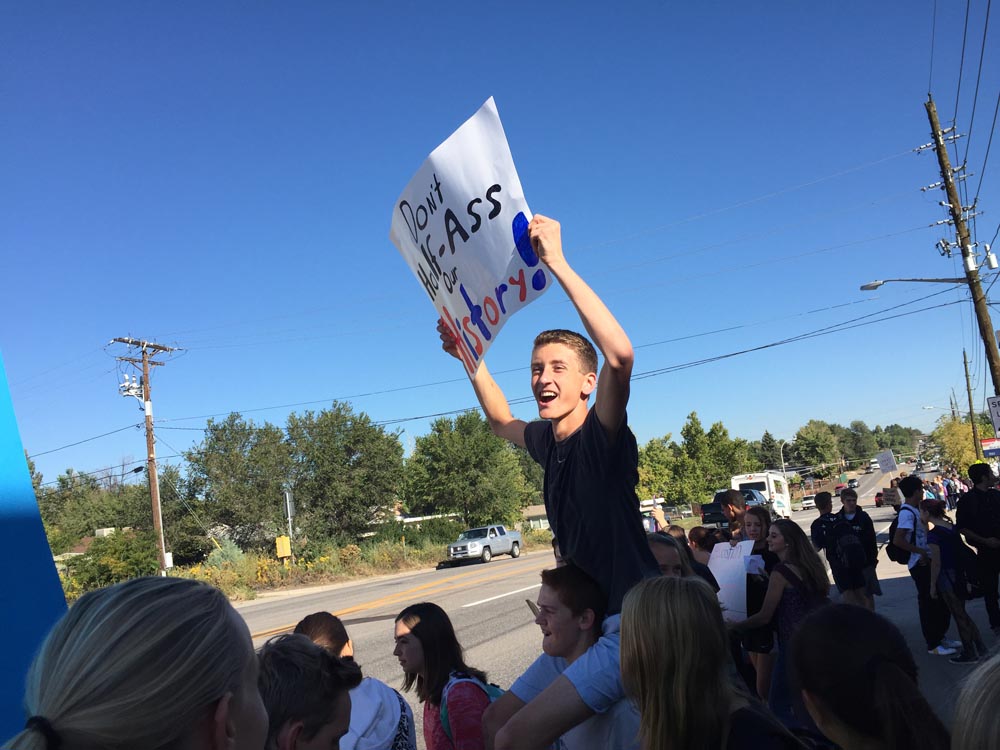13 Nov The students protesting for their high school history curriculum are fighting for JAs, too

Hundreds of Lakewood High School students, including this one, left their classrooms in September to protest a proposed history curriculum they believed would lead to censorship. Students organized the walkouts using social media sites like Facebook. (Photo by Nic Garcia/Chalkbeat Colorado)
I grew up as part of a generation that found our collective voice in protest, for African American civil rights, against the war in Vietnam, and to advocate for women’s and LGBT rights and Asian American studies.
College students have been at the forefront of many of these social movements. The Student Non-Violent Coordinating Committee was a cornerstone of the civil rights movement. College students led the free speech movement at the University of California at Berkeley, and the left-wing Students for a Democratic Society was formed at the University of Michigan. Students led protests across the globe, including the Prague Spring in 1968 all the way to the Tiananmen Square protests of 1989. Even the Taiwan protests earlier this year and the current and Hong , Kong democracy protests.
But in Colorado where I live, my admiration goes out to a group of high school students, who have been protesting in Jefferson County, the school district where I graduated in the 1970s.
Those students have been protesting against efforts by the Jefferson County R1 School District, or at least, some of its school board members, to review an Advanced Placement (AP) History Curriculum Framework because conservative members of the board claimed it was not patriotic enough, and focused too much on negative aspects of American history.
When the new AP history guidelines were announced, conservatives across the U.S. objected but Jefferson County school board member Julie Williams made the national spotlight with her comments, and the ensuing student protests. She said the new curriculum focused too much on the negative events that painted America in a bad light, by focusing on topics like slavery. She told education news website Chalkbeat Colorado, “There are things we may not be proud of as Americans, but we shouldn’t be encouraging our kids to think that America is a bad place.”
Instead, she said in her proposal to review the curriculum, American history should “promote citizenship, patriotism, essentials and benefits of the free-market system, respect for authority and respect for individual rights.”
Because the framework would cover the civil rights movement and Vietnam war and the protests that accompanied the era, Williams thinks the history course would “encourage or condone civil disorder, social strife or disregard of the law.”
Her criticism sparked civil disorder instead. Students began protesting as the school year began in September, eventually skipping classes to protest in front of the district’s administration building. When some teachers started calling in sick in protest too, the district closed some of its schools on some days. (You can read all the coverage of the protests including the most recent stories at Chalkbeat Colorado, a website that covers education in the state.)
I’ve read the AP History Curriculum Framework, and I’m astounded that anyone would say the proposed guidelines are negative and would encourage students to be anti-American. Never mind that protesting is as American as apple pie (hello, Boston Tea Party?).
The new curriculum is important and valuable precisely because shows the true scope of American history, warts and all. The Curriculum Framework mentions the internment of Japanese Americans as an opportunity to ask students to think about challenges to civil liberties and study our country’s debates about race and segregation, and also suggest that teachers can “choose to examine the restrictions of rights during America’s wars in contrast to the opportunities for minorities to show their patriotism by serving in the armed forces, such as the internment of Japanese Americans and the heroism of Daniel Inouye in World War II.”
That’s powerful stuff for me. When my stepson was in high school a decade ago, he brought home a brand-new history textbook from his high school – in Jefferson County, Colorado. It covered World War II over more than 60 pages. But it only reserved two paragraphs for internment. It was as if the Japanese American experience was an afterthought, a footnote to history.
I was disgusted by that schoolbook. I’m all for the new AP history guidelines. Bravo, students. Thank you. You give me hope for the future.
Note: This post was originally written for the Pacific Citizen, the national newspaper of the JACL, the country’s oldest Asian American civil rights organization. I’m a member of the PC’s Editorial Board.




